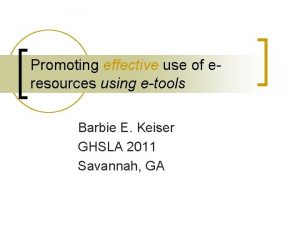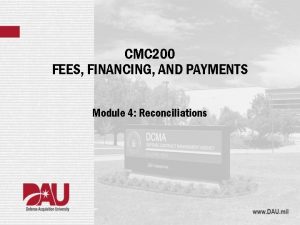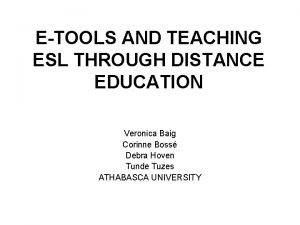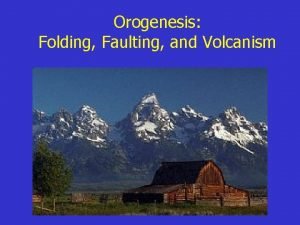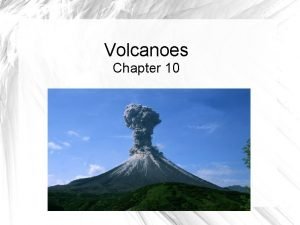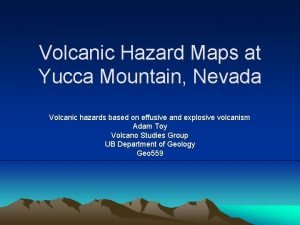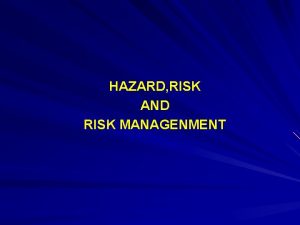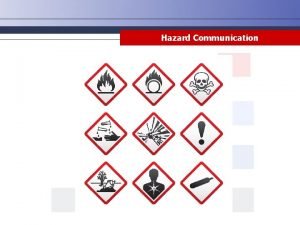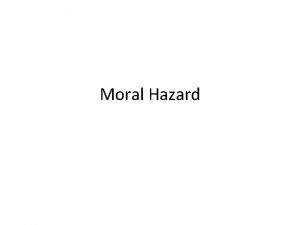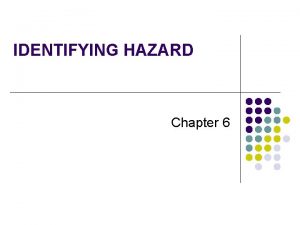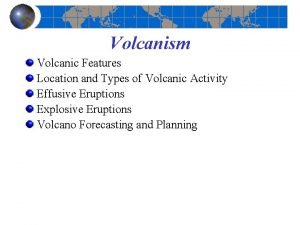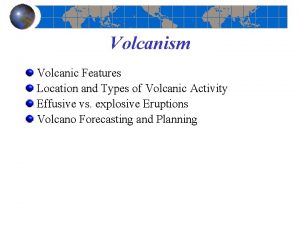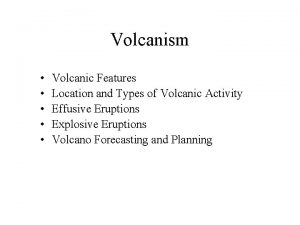DEVELOPMENT AND IMPLEMENTATION OF eTOOLS FOR VOLCANIC HAZARD










- Slides: 10

DEVELOPMENT AND IMPLEMENTATION OF e-TOOLS FOR VOLCANIC HAZARD ASSESSMENT AND RISK MANAGEMENT (Ve. TOOLS) Co-ordinator: Agencia Estatal Consejo Superior de Investigaciones Científicas (CSIC), Spain Beneficiaries: - School of Earth Sciences, University of Iceland (Uo. I), Iceland - Faculty of Sciencies, University of Lisbon (FCUL), Portugal EC ECHO A. Civil Protection Unit, Brussels 20 th January 2015

MOTIVATION Volcanic hazard is the probability of any particular area being affected by a destructive volcanic event within a given period of time. The complexity of any volcanic system and its associated eruptive processes, together with the lack of data that characterise many active volcanoes, particularly those with long intervals between events, make volcanic hazard quantification very challenging, as there is often not enough observational data to build a robust statistical model. Assessment of volcanic hazard from future eruptive scenarios in probabilistic ways has become a widely used technique for risk evaluation in recent years. So, to quantify volcanic hazard, we need to estimate probabilities of occurrence of a particular eruptive scenario in time and space. Volcanic crises are complex and challenging to manage because of the inability to view directly the subsurface processes that operate before eruption and, during eruption, because of the time-dependent behaviour of volcanic hazards. As a result, decisions taken during emergencies are based on evaluations that contain significant uncertainty and so test the ability of communities to protect themselves and their infrastructure, as well as their ability to recover from an eruption The Coordinator (CSIC group) has pioneered the development of friendly-user e-tools able to be used with personal computers specifically addressed to long-and short-term hazard assessment, vulnerably analysis, decision making, and volcanic risk management. The purpose of this project is to evaluate the feasibility and applicability through the analysis of each particular tool by different groups of experts with experience on regions representing different volcanological and socioeconomic scenarios, and to incorporate in this evaluation exercise the potential end members (Civil Protection agencies) in order to test the adaptability of the existing tools to their needs and requirements, and to train them in their use. EC ECHO A. Civil Protection Unit, Brussels 20 th January 2015

EC ECHO A. Civil Protection Unit, Brussels 20 th January 2015

OBJECTIVES: The main goal pursued by Ve. TOOLS project is to create an integrated software platform specially designed to assess and manage volcanic risk. The project will facilitate interaction and cooperation between scientists and Civil Protection Agencies in order to share, unify, and exchange procedures, methodologies and technologies to effectively reduce the impacts of volcanic disasters by improving assessment and management of volcanic risk. The project aims at: improving and developing volcanic risk assessment and management capacities in active volcanic regions; developing universal methodologies, scenario definitions, response strategies and alert protocols to cope with the full range of volcanic threats; improving quantitative methods and tools for vulnerability and risk assessment; and defining thresholds and protocols for civil protection. The target of the project is volcanic islands as they represent highly vulnerable natural and socioeconomic systems and constitute an important part of Europe that geographically extend the boundaries of the community around the world. The project will concentrate on the eastern Atlantic volcanic islands (Canaries, Azores, and Iceland), which cover a wide range of volcanological and socioeconomic scenarios, with the aim of exporting the results obtained to the other European volcanic islands, but also to the continental active volcanic regions. The duration of the project is 18 months EC ECHO A. Civil Protection Unit, Brussels 20 th January 2015

PROJECT BUDGET: EC ECHO A. Civil Protection Unit, Brussels 20 th January 2015

PARTNERS: Role Institution Acronym Country Scientist in charge Co-ordinator Agencia Estatal Consejo Superior de Investigaciones Científicas CSIC Spain Joan Marti Beneficiary School of Earth Sciences, University of Iceland Uo. I Iceland Armann Hoskuldsson Beneficiary Faculty of Sciences, University of Lisbon FCUL Portugal Antonio Brum EC ECHO A. Civil Protection Unit, Brussels 20 th January 2015

EXPECTED RESULTS A virtual agora (open web site) for volcanic risk assessment and management, addressed to scientist and professional involved in volcanic risk, offering a virtual channel for communication, information exchange, dissemination of scientific and technical innovations, and storage and use of e-tools A package of general guidelines for appropriate model application and development within the context of hazard assessment. A set of procedures, protocols and classifications needed for defining inventories of elements at risk from volcanic eruptions, determining appropriate vulnerabilities to the principal volcanic and associated hazards, both to property and people, and carrying out impact assessments based on given volcanic eruption scenarios and with global application. A set of probabilistic and statistical techniques for volcanological data analysis and treatment in the context of quantitative hazard and risk assessment and the harmonisation of approaches and protocols for decisionsupport in civil protection. A GIS-based automatic system that will incorporate libraries with simulation models, databases and vulnerability functions, efficient probabilistic methodologies and the standard protocols for preparedness planning. A set of protocols, templates and formats for presenting science-based hazard and risk estimates to Civil Protection for risk-based decision-making. EC ECHO A. Civil Protection Unit, Brussels 20 th January 2015

Task ID Task Title Start Date End Date 1 Management and reporting to the Commission 01/01/2015 30/06/2016 Organisation of the Project Management Committee meetings during the general workshops, editing progress report, circulation of relevant results derived from the project, and general coordination (scientific and financial) of the project. Creation of the project website First progress report (30/06/2015) Second progress report (31/12/2015) Final project report (31/06/2016) 2 Publicity 01/01/2015 30/06/2016 To create a virtual agora (web site) for volcanic risk assessment and management Virtual Agora and corresponding tutorial documentation (30/04/2015) Information and dissemination activities and products Technical reports and papers 3 General workshops 01/01/2015 30/06/2016 Discussion forum for presenting and training the available e-tools for volcanic hazard assessment and management, and for learning on the different structures and problematics of different Civil Protection Agencies in front of volcanic threat. In addition of project partner and their corresponding local Civil Protection Agencies, other European Civil Protection Agencies and Research Groups will be invited by the project to participate in this discussion forums in order to enhance European participation and implement the benefit from the project results and the widest level List of requirements and needs from Civil Protections to implement available e-tools (30/06/2015) Definition of guidelines for volcanic risk assessment and management in three case studies: the Canaries, Iceland Azores. And from other European regions with similar problems 4 Database 30/04/2015 Definition of a database architecture for volcanic risk assessment and management based on easy data storage and sharing Database structure for volcanic risk assessment and management 5 GIS platform 01/01/2015 30/06/2015 Programming activities to adapt the existing GIS Core of the software package and Creation of interfaces and software QGIS (the core of the final software package) protocols to the purposes of the project. Programming activities to define user-friendly interfaces and protocols to upload data, execute, visualize results, and download data from a browser 6 Volcanic scenarios modelling 01/07/2015 7 Probabilistic methodologies 01/01/2016 01/01/2015 31/12/2015 30/06/2016 Actions Deliverables Programming activities to define the protocols to incorporate selected and future volcanological and geographic scenarios (WP 3) and physical models (WP 4) to the open libraries of resources. Models should be independent executable applications (i. e. external to the core of the program) compatible with the interface Set of simulation models for eruptive scenarios and documentation concerning models included in the software tools, Programming activities to define the protocols to Set of probabilistic methodologies and related data and documentation incorporate selected and future probabilistic methodologies 8 Decision making models 01/01/2016 30/06/2016 Implementation into the integrated software platform a Bayesian Decision Making Model, already partially developed the CSIC group, as a general and flexible, probabilistic model for volcano crisis management. An easy to use application useful for decision makers EC ECHO A. Civil Protection Unit, Brussels 20 th January 2015

TENTATIVE DATES AND PLACES FOR MAJOR EVENTS General workshop Canary Islands (Tenerife) This workshop will be organised at the first part of the project (between month 1 and 6) and will be devoted to present the objectives of the project, to show and train on the available tools for volcanic risk assessment and management, to identify their main drawbacks and weaknesses, to define the guidelines for their improvement and implementation, and to know the particular experience of the Canarian Civil Protection and the Spanish Civil Protection and to analyse their main needs and requirements to face volcanic threat and how the proposed tools may help them to achieve such complex task General workshop Iceland This workshop will be organised at the middle of the project (between month 8 and 9) constituting a progress meeting that analyse the progress made since it started and will help to redefine objectives in case of any deviation from the original plans caused by scientific, technical or logistical difficulties found during the development of the project. It will be also devoted to present the progress done with the development of the e-tools according to the improvements and modifications suggested in the first workshop, to identify potential new drawbacks and weaknesses, and if this is the case to define the guidelines for their improvement and implementation, and to know the particular experience of the Icelandic Civil Protection and to analyse their main needs and requirements to face volcanic threat and how the proposed tools may help them to achieve such complex task General workshop Azores (Pico) This workshop will be organised towards the end of the project (between months 15 and 17) constituting the final test of the e-tools developed in the project and of their feasibility in the use by scientists and Civil Protection Agencies. We will analyse the main needs and requirements to face volcanic threat the local Civil Protection Agency has and how this European project may help at the time that European partners and collaborators will know what they could learn from experiences outside Europe Thematic meetings among partners During the development of the project it will be necessary for the partners to meet apart from the general workshop to discuss particular aspects of the project, such as integration of data, testing of occasional modifications of tools, homogenisation of criteria among participant, discussion on the development of the project, etc…… EC ECHO A. Civil Protection Unit, Brussels 20 th January 2015

FOLLOW UP: The main task to be done after the completion of the project is to implement the use of the integrated software platform for assessment and management of volcanic risk and the corresponding e-tools included in the normal procedures of European Civil Protection Agencies when dealing with volcanic threat and to let it know to foreign Civil Protection about the results of this project. Therefore, some additional dissemination and demonstration activities inside and outside Europe will be necessary after the completion of the project. In addition, progressive updates of the integrated software platform and of its e-tools will be necessary due to expected improvement in the GIS platform and on the simulation models of volcanic processes with time, as well as on the volcanological and socioeconomic knowledge of each regions, so that the database on which the systems relies will be to progressively updated too. The е-tools, hosting costs, periodic maintenance and service after the completion of the project will be responsibility of the co-ordinator (CSIC) as part of its internal activities. The resources necessary to undertake such activities after the completion of the project should not represent a significant additional cost and should be able to be achieved under the normal behaviour and budged of the involved institutions. EC ECHO A. Civil Protection Unit, Brussels 20 th January 2015
